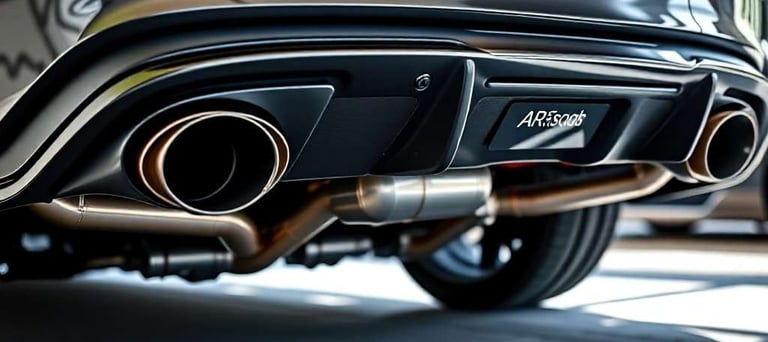Cat Back Exhaust Kits: Boost Performance and Sound
Cat back exhaust kits are aftermarket systems designed to replace the section of a vehicle’s exhaust that starts from the catalytic converter. These kits enhance engine performance by improving exhaust flow and can significantly alter the sound of the vehicle. They typically include components like pipes, mufflers, and exhaust tips. These kits not only provide performance benefits but also contribute to the aesthetic appeal of the vehicle. The following sections will explore popular brands, installation tips, and factors to consider before purchasing a kit.
Understanding Cat-Back Exhaust Kits
Cat-back exhaust systems offer significant enhancements to both vehicle performance and auditory experience. This section delves into their definition, essential components, and how they contribute to a car's overall functionality.
Definition and Key Components
A cat-back exhaust system refers to the portion of the exhaust system that extends from the catalytic converter to the rear of the vehicle. This encompasses various components that work in synergy to optimize exhaust flow. Key elements include:
Pipes: Typically constructed from stainless steel or aluminized steel, these pipes are designed for durability and resistance to high temperatures.
Mufflers: These are essential for noise regulation. Depending on their design, they can yield a range of sound outputs, from subtle to aggressive.
Exhaust Tips: These are not merely decorative; they can impact sound and performance while enhancing the vehicle's appearance.
Accessories: Various mounts, clamps, and gaskets that facilitate proper installation and ensure that the system functions effectively.
How Cat-Back Systems Enhance Vehicle Performance
The primary function of a cat-back exhaust is to improve exhaust flow. By reducing back pressure, these systems allow the engine to expel gases more efficiently. The results often translate into:
Increased Horsepower: A more efficient exhaust system can lead to noticeable gains in engine output.
Improved Torque: Enhanced exhaust flow supports better torque delivery, providing a more responsive driving experience.
Fuel Efficiency: With less obstruction in exhaust flow, engines can operate more efficiently, potentially leading to better fuel economy.
Sound and Aesthetic Benefits
One of the most appealing aspects of cat-back exhaust systems is the distinctive sound they produce. Depending on the muffler design and pipe diameter, the sound can range from a low rumble to a pronounced roar. This auditory enhancement appeals particularly to car enthusiasts who value the auditory presence of their vehicles.
From an aesthetic standpoint, cat-back systems can dramatically transform the rear end of a vehicle. Stylish exhaust tips and polished finishes can elevate the overall appearance, making the car look more aggressive and sporty. This combination of sound and style often influences buyer decisions significantly.
Popular Cat-Back Exhaust Brands
Several brands have established themselves as leaders in the cat-back exhaust market, known for their quality, performance, and innovative designs. Below are two of the most popular brands, highlighting their features and benefits.
Borla Cat-Back Exhaust Features
Advantages of Borla Design
Borla cat-back exhaust systems are renowned for their superior craftsmanship and engineering. Some key advantages include:
Durable construction using high-quality stainless steel, which resists corrosion.
Performance-oriented design aimed at maximizing exhaust flow and minimizing back pressure.
Aggressive sound profiles that appeal to performance enthusiasts.
Various options tailored to specific vehicle models for optimal fit and performance.
Installation and Compatibility
Borla exhaust systems are often designed for easy installation. Most kits come with all necessary hardware and instructions, making them suitable for DIY enthusiasts. Compatibility is wide-ranging, with options available for numerous makes and models of vehicles, ensuring a perfect fit.
MagnaFlow Cat-Back Exhaust System
Benefits and Specs
MagnaFlow cat-back exhaust systems are acclaimed for their powerful sound and performance enhancement. Key features include:
Robust construction materials ensuring longevity and reliability in performance.
Increased horsepower and torque due to improved exhaust flow efficiency.
Signature deep tone that enhances the driving experience.
A variety of styles and configurations tailored to different vehicle needs.
User Feedback and Reviews
User feedback often highlights the noticeable improvement in engine sound and performance after installing a MagnaFlow system. Many owners appreciate the brand's focus on producing systems that deliver both power and a pleasing auditory experience. Positive reviews frequently emphasize the build quality and the ease of installation, making MagnaFlow a favorite among car enthusiasts.
Cat-Back Exhaust for Specific Vehicles
Specific vehicles, like the Ram 1500 and others, benefit significantly from tailored cat-back exhaust systems. These upgrades enhance performance and sound, making them a popular choice among enthusiasts.
Cat-Back Exhaust for Ram 1500
Performance Gains on Ram 1500
The Ram 1500, a versatile truck, responds well to cat-back exhaust modifications. These systems generally provide noticeable improvements in horsepower and torque, which can range from 5 to 15 additional horsepower. The enhanced flow allows the engine to expel exhaust gases more efficiently, leading to a more responsive throttle and improved acceleration.
Installation Tips for Ram Models
Installing a cat-back exhaust on a Ram 1500 can be straightforward, thanks to its design. Here are some tips to consider during installation:
Ensure that all necessary tools are on hand, including wrenches, clamps, and a jack.
Follow the manufacturer's instructions meticulously to avoid installation errors.
Consider using a partner to help position the components accurately.
Verify all connections for leaks after the installation is complete.
Other Vehicle Models with Recommended Cat-Back Exhausts
Considerations Based on Vehicle Type
Different vehicles require specific exhaust setups to maximize benefits. Performance cars, SUVs, and trucks may each have unique requirements for sound and efficiency. Generally, enthusiasts should consider their vehicle's engine size, intended use, and sound preferences when selecting a cat-back system.
OEM Catalytic Converters and Compatibility
When upgrading to a cat-back exhaust, it is crucial to check compatibility with OEM catalytic converters. Ensuring that the new exhaust system fits correctly with existing components prevents potential legal issues and maintains vehicle performance. Some manufacturers provide detailed compatibility charts to assist buyers in making informed choices.
Price and Value of Cat-Back Exhaust Kits
Understanding the price and value of cat-back exhaust kits is crucial for any automobile enthusiast considering an upgrade. Various factors can significantly impact pricing, and evaluating cost versus performance can help in making an informed decision.
Factors Influencing Cat-Back Exhaust Price
The price of cat-back exhaust kits can vary widely due to several key factors:
Material Quality: Kits made from stainless steel generally cost more than those made from aluminized steel due to their durability and resistance to corrosion.
Brand Reputation: Well-known manufacturers often charge a premium for their designs, backed by years of research, development, and customer satisfaction.
Design Complexity: Systems that are engineered for specific makes and models may incur higher costs due to custom fittings and enhanced performance features.
Included Accessories: Kits with additional components such as hangers, gaskets, and clamps will usually have a higher price point compared to bare systems.
Cost vs. Performance Ratio
Evaluating the cost versus the performance gains is essential for those looking to enhance their vehicle's capabilities. Many enthusiasts consider the following:
Horsepower Increase: Most cat-back exhaust kits can improve horsepower by an average of 5 to 15 HP. The cost per horsepower gained can help determine if a system is worth the investment.
Torque Gains: Along with horsepower, torque improvements can significantly affect driving experience, especially for trucks and performance vehicles.
Fuel Efficiency: Some systems improve exhaust flow, potentially leading to better fuel economy. This factor can contribute to the overall value equation.
Long-term Investment and Vehicle Value
Investing in a quality cat-back exhaust kit can contribute positively to the long-term value of a vehicle. Key considerations include:
Resale Value: Upgraded exhaust systems can be attractive to potential buyers looking for performance enhancements, thus increasing resale potential.
Longevity and Maintenance: Higher-quality materials tend to last longer, reducing long-term maintenance costs. This durability can offset the initial investment over time.
Performance Appeal: As market trends favor performance upgrades, having a cat-back exhaust system in place can make the vehicle more appealing to enthusiasts.
Installing a cat-back exhaust system can significantly enhance a vehicle's performance and sound. Following best practices ensures a smooth installation process and optimal performance.
Best Practices for Cat-Back Exhaust Installation
Required Tools and Preparations
Before beginning the installation, it's important to gather all necessary tools and prepare the work area. Having everything on hand will save time and minimize frustration.
Tools Needed:
Socket wrench set
Screwdrivers (flat and Phillips)
Jack and jack stands or ramps
Torque wrench
Cut-off tool or pipe cutter (if necessary)
Safety glasses and gloves
Preparations:
Park the vehicle on a level surface to ensure safety.
Ensure the engine is cool to avoid burns.
Read the installation manual provided with the exhaust kit.
Inspect all components for damage.
Step-by-Step Installation Guide
Once all tools and preparations are in place, adhere to the following steps for a successful installation:
Remove the Existing Exhaust:
Loosen and remove the bolts connecting the factory exhaust system at the flanges.
Cut the old exhaust with the cut-off tool if necessary, ensuring to leave enough pipe for connections.
Detach the hangers holding the old exhaust in place.
Install the Cat-Back Exhaust:
Start with the front pipe and connect it to the catalytic converter.
Align the new pipes and silencer, ensuring the hangers fit securely into mounts.
Tighten all bolts according to the manufacturer’s specifications using a torque wrench.
Final Adjustments:
Check alignment and adjust for proper fit.
Start the engine and listen for any leaks.
Make sure the exhaust does not come into contact with any other parts of the vehicle.
Troubleshooting Common Issues
Even with proper preparation and installation, issues may arise. Troubleshooting can help resolve these quickly:
Leakage: Inspect all connections for leaks or gaps. Use exhaust sealant if necessary.
Noise Issues: Excessive noise may indicate loose components. Tighten bolts and ensure the system is securely hung.
Vibrations: If vibrations occur, check for misalignment and adjust hangers accordingly.
FAQs on Cat-Back Exhaust Systems
This section addresses common questions regarding cat-back exhaust systems, including their impact on vehicle emissions, differences from other exhaust types, and guidance on selecting the right components for specific vehicles.
Impact on Vehicle Emissions
Cat-back exhaust systems can influence vehicle emissions, primarily depending on the design and the regulations in place. While some aftermarket systems improve exhaust flow, they may not always align with environmental standards.
Key points to consider include:
The impact of reduced back pressure on engine efficiency.
Compliance with local emissions regulations, as some systems may not meet state or federal guidelines.
Potential fines or penalties for non-compliance.
Differences Between Cat-Back and Other Exhaust Systems
Understanding how cat-back systems differ from other exhaust types is essential for vehicle owners. These distinctions help clarify what benefits each type provides. The most notable differences include:
Cat-back systems typically replace only the section of the exhaust system from the catalytic converter back, while full exhaust systems replace the entire setup, including headers.
Sound levels vary significantly; cat-back systems usually offer custom sound profiles, which differ from stock systems designed for quiet operation.
Performance enhancements are usually more pronounced in cat-back systems, focusing on flow dynamics without affecting engine emissions directly.
How to Choose the Right Parts for Your Vehicle
Selecting the appropriate cat-back exhaust kit requires careful consideration of several factors to ensure compatibility and performance enhancement.
Factors to keep in mind include:
Vehicle model and specifications: Ensure the kit is designed for your specific make and model, as fitment varies greatly.
Material choice: Options like stainless steel offer more durability than aluminized steel, especially under harsh driving conditions.
Desired performance characteristics: Consider whether a louder, more aggressive sound is preferred, or if a milder tone is sought.
Budget constraints: Pricing for cat-back systems can range widely; setting a budget can help narrow down options.


Motorsport
Experience exceptional racing with our expert guidance.
Rodiauto Sport LLC
500 4TH ST NW Suite 102
87102 Alburquerque - NM - US.
Advice
Services
info@rodiautosport.us
© 2025. All rights reserved.
